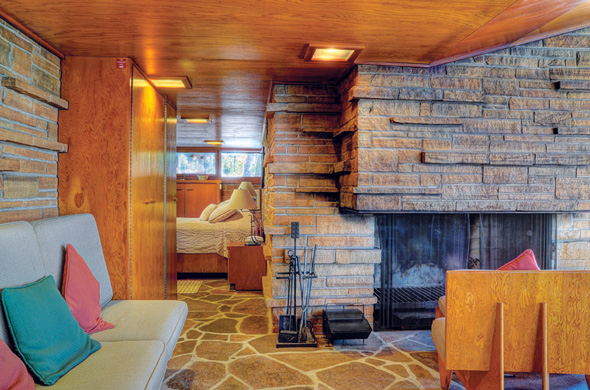The best view of Mirror Lake isn’t the closest one. It’s set back from the water several hundred yards, where a keyhole in the forest reveals the sun setting beyond the lake’s glassy surface, casting a warm orange glow. The spot isn’t perched among the pine boughs, though that’s just how it feels. A thin seam between two huge pieces of glass is the only clue that you’re indoors.
The Seth Peterson Cottage, tucked into a wooded area just beyond Wisconsin Dells, exemplifies organic architecture—a man-made space harmoniously integrated with its natural surroundings. It’s one of the few Frank Lloyd Wright–designed residences that accommodates overnight guests, offering a rare chance to inhabit the work of America’s most famous architect.
The cottage is not among the Wisconsin native’s best-known works (Fallingwater, the Guggenheim); Wright took the modest commission in 1958, at the twilight of his career. Sadly, neither he nor the cottage’s owner, Seth Peterson, lived to see the project completed and, by 1966, the land was purchased by the state of Wisconsin when it created Mirror Lake State Park. The building was boarded up and largely forgotten until, two decades later, a group of preservationists rediscovered the cottage in a state of extensive disrepair: roof caved in, windows broken, mechanical systems unsalvageable. Only the stone floor, walls, and massive fireplace hearth remained in good condition, anchoring the structure like a sturdy tree trunk. After an extensive restoration, the roof once again lofts like a bird’s wing to protect a wall of south-facing windows that let in the sun-dappled light.

Photo by Kit Hogan
The cottage’s 880 square feet feel both spacious and cozy. A galley kitchen leads to an open, airy, light-filled dining space, where a rich stain makes the humble plywood walls and ceiling look luxurious. Around the corner, a lower roofline lends intimacy to fireside seating as well as the sleeping and bathing quarters. In the bedroom, which is large enough only for a mattress and closet from their pre-supersize era, high windows stave off daybreak. The flagstone floor begs to be padded across barefoot, having the warmth and texture of packed beach sand.
In the guest book, several missives are penned in the blocky capitals that architects favor. One describes the visit as “a lively experience we will remember when sitting on the back porch of life.” And it feels exactly so: like a habitable work of art.

Photo by Nick Collura, courtesy of Travel Wisconsin
What to do
See the Dells as they were before being colonized by water parks and thronged by fudge-sticky tourists. Touring the fjords of Wisconsin—narrow gorges with striped sandstone cliffs—via the cottage’s canoe feels like entering a portal to another universe.
Where to eat
A mere 20 minutes paddle from the cottage will rewind the clock half a century, when the Ishnala Supper Club first affixed itself to the lake’s steep bank (prior to modern building codes). It hasn’t changed a bit: The bar and dining room jut out over the lake like a ship’s prow; Norway pines pierce the roof; and Native American artifacts double as décor. Knock back an old-fashioned then order the surf and turf to get a taste of why the Wisconsin supper club reigns supreme.
ishnala.com
Read more:
Red Wing Shoes
Product Design; Red Wing, MN
Faribault Woolen Mill Co. Blankets
Textiles; Fairbault, MN
Frank Lloyd Wright’s Seth Peterson Cottage
Architecture; Wisconsin Dells, WI
Kohler Plumbing Fixtures
Product design; Kohler, WI
Camp Wandawega
Interior design; Elkhorn, WI






